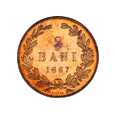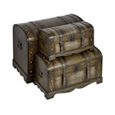Adornment hoards of Byzantine influence
Texts: Dr. Silviu Oța / Photo: George Nica
Oțeleni hoard (bracelet). Material: silver. Technique: casting, enameling, engraving. Voineşti hoard (twisted wire bracelets, earrings, buckles). Material: silver, silver gilt. Technique: drawing, twisting, filigree, granulation, batter. Sviniţa hoard (pendant earrings). Material: silver. Technique: drawing, twisting, filigree, granulation, spiraling. Olteni hoard (earrings). Material: silver gilt. Techniques: twisting, filigree, granulation, spiraling.
Being introduced under Byzantine influence, the art of working precious metals dates on the present territory of Romania ever since the 7th century and is known through a series of discoveries of jewelry and clothing accessories. After a period during which the entrance of Balkan jewelry north of the Danube decreased, it intensified following the re-establishment of Byzantine borders on the Lower Danube in the 10th century and the conquest of the territory situated south of the river in the 11th century. This continued until the beginning of the 13th century, when Constantinople was conquered by the crusaders. Within the entire Balkan area, the tradition of manufacturing Byzantine-style jewelry was preserved in the old urban centres of jewelry production, as well as in villages. From the 14th century onwards, apart from items which entered north of Danube through commercial exchanges, it is documented the local production of Byzantine-style jewelry, especially after the territory south of the Danube was conquered by the Byzantines.
Regardless of the provenance of jewelry and clothing accessories, starting with the 13th century but mostly during the 14th century an important number of hoards were buried, among which are numbered those discovered in Voinesti, Oteleni, Olteni and Svinita. All these comprise Byzantine-style pieces, made by artisans from the Balkans or from the old Russian space.
THE HOARD FROM VOINEȘTI (Iași) was discovered in 1926 and it was one of the most important in a series of such findings of Byzantine-style pieces. It contains 31 pieces of jewelry and clothing accessories, whole or broken, manufactured from silver and silver gilt. The hoard contains two sets of pieces, some of oriental Byzantine tradition and others of old Russian tradition. Twisted bracelets, manufactured out of silver and decorated in the granulation and the filigree techniques, are known in a wide area (Romania, Serbia, Bulgaria), especially during the 13th-14th century.
THE HOARD FROM OŢELENI-DELENI was discovered by chance in 1921, during a series of agricultural works. The jewelry and coins were hidden in a ceramic pot covered by a lid made out of the same material. Initially, it was composed out of 300-400 silver and gold coins, three bracelets, two pairs of earrings and a diadem. Some of the pieces were lost or made their way into different collections. The pieces that were recovered include of a few tens of coins, two bracelets, a fragment of a third bracelet and three earrings.
In the 1990s, in SVINITA (Mehedinti County) a pair of silver earrings with a particular artistic value was discovered by chance. They are manufactured from silver, in the granulation and the filigree techniques, with the link put in two and twisted, and, as far as the style of execution of their pendants is concerned, they are part of a larger seried of items discovered in basin of the Middle Danube. The earrings from Svinita represent, at least on the current Romanian territory, the eldest pair with this type of stylized structure.
THE HOARD DISCOVERED IN OLTENI (Teleorman County), in 1959 as a result of agricultural works, contains jewelry with gilded silver, with a total weight of approximately 800 grams. Additionally, the hoard contains fragments of a metal tray, clothing accessories consisting of belt ornaments, belt prongs, buckles with plaques, belt buckle, silver buckles, earrings, rings and diadem plates with necklaces and pendants. The treasure is very complex in terms of the origin of the pieces. The execution styles as well as the decorative motifs of the jewelry and clothing accessories indicate both Balkan and central European workshops.

















